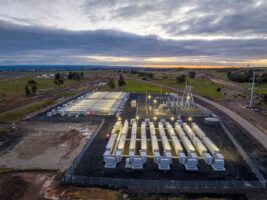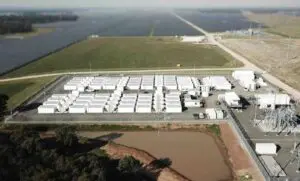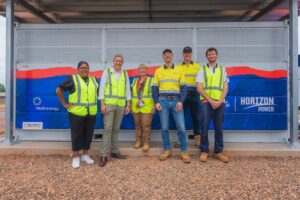Listed renewable energy developer and operator Infigen Energy says its newly commissioned Lake Bonney big battery is performing “above expectations”, and is helping it boost revenues and contracting as well as opening up opportunities for more wind and solar.
Lake Bonney – after nearly six months of delays now common to the energy industry – came into full production in late November and the 25MW/52MWh Tesla battery is earning money from roughly equal measures from energy arbitrage (buying low and selling high) and from frequency and ancillary services.
This month, however, the battery has played a key role in helping the Australian Energy Market Operator manage the South Australia grid, which was “islanded” when storms tore down the main transmission link to Victoria and AEMO turned to the state’s three big batteries to help key the lights on.
Infigen CEO Ross Rolfe told investors on Friday that the FCAS revenue earned by the Lake Bonney battery offset the loss of revenue from having its biggest asset, the 275MW Lake Bonney wind farms, shut down, along with three other wind farms, because of the stricken transmission line.
FCAS requirements and prices soared during the islanding of South Australia and analysts suggest that the three big batteries in the state – Lake Bonney, Hornsdale and Dalrymple North could have generated revenue of around $45 million during the two and a bit weeks it was acting as an island.
The Lake Bonney battery is one of three “fast-start” assets that Infigen has secured in the last 12 months to “firm” the output of its renewable energy portfolio, along with the 123MW Smithfield generator in NSW and the 120MW of South Australia fast start generators it will lease from the government from May.
Infigen says these “fast start” assets, and the ability to deliver “firm supply” to commercial and industrial customers, will allow it to double its current renewable energy capacity, and add 600-700MW of new capacity.
In that light it is looking to reach financial close of its 138MW Flyers Creek wind project in NSW, and is talking to other project developers and customers about power purchase agreements. Rolfe says new contracts would likely be in wind energy, and it has recently contracted to take the output from the small 21MW Toora wind farm in Victoria.
But Rolfe and the company’s energy markets chief Paul Simshauser say the task is being made complicated by political and regulatory uncertainty, and pointed to Angus Taylor’s Underwriting New Energy Investment scheme, which is creating uncertainty because it is not clear which projects it will support, where and how.
Other leading energy CEOs have also complained that UNGI is causing investment decisions to be delayed. Origin CEO Frank Calabria said on Thursday that it was clouding its own decisions on a new battery or fast start generator in Victoria because of the proposed government support for a rival project at Dandenong.
“There is an uncertain policy and regulatory environment , and the government wants to intervene increasingly in the market,” Rolfe said. “It’s against their principle of competitive neutrality.”
Simshauser also pointed to the controversial COGATI rules being pushed by the Australian Energy Market Commission, which proposes to co-ordinate generation and transmission investment, but which are being widely criticised because of their complexity and potentially perverse outcomes. And new connection rules that came into effect in 2018 has also created problems.
Simshauser says it is challenging trying to executive power purchase agreements when there was a “lot of noise” in the policy and regulatory space. He said the COGATI negotiations have added time, cost and risk to all parts involved.
In the past six months, Infigen reported a 17 per cent lift in generation – largely due to the new Bodangora wind farm – which helped deliver a 13 per cent lift in overall revenue to $138 million, and an 11 per cent lift in underlying earnings to $98 million.
The Smithfield fast-start gas generator was rarely used – only three per cent of the time – but played a crucial role because it allows Infigen to meet its contracted deliveries and dodge the pricing peaks. Its sparing use gives a glimpse of how gas might be deployed in a future grid dominated by renewables.
“We’d rather get low-cost renewables into the system than burn gas,” Simshauser said, noting that even at current low prices of around $6 a gigajoule, a gas generator like Smithfield still needs $80/MWh to cover the cost of fuel, let alone maintenance and other costs.
Simshauser noted the conversation in energy circles had changed from baseload, intermediate and peak to renewables and batteries and fast start gas plants, and maybe pumped hydro if “we can get those numbers to work.”
He saw potential synergies in batteries for both generating companies and network companies, tapping into the number of different services that batteries could provide. They were not a cure-all, he said, but they could cure many of the issues.
On the trading practice he noted: “The battery scours through the spot electricity market for frequency regulation, raise and lower, and contingency …. it’s got nine spot markets that it is scouring through and it dispatches itself into the most profitable of those,” under the watchful eye of the markets team.
Rolfe also confirmed that Tim Nelson, currently with the Australian Energy Makes Commission, will join the company to head the energy markets division at Infigen, and will replace Simshauser, who is to be the new CEO at Queensland transmission company Powerlink.









